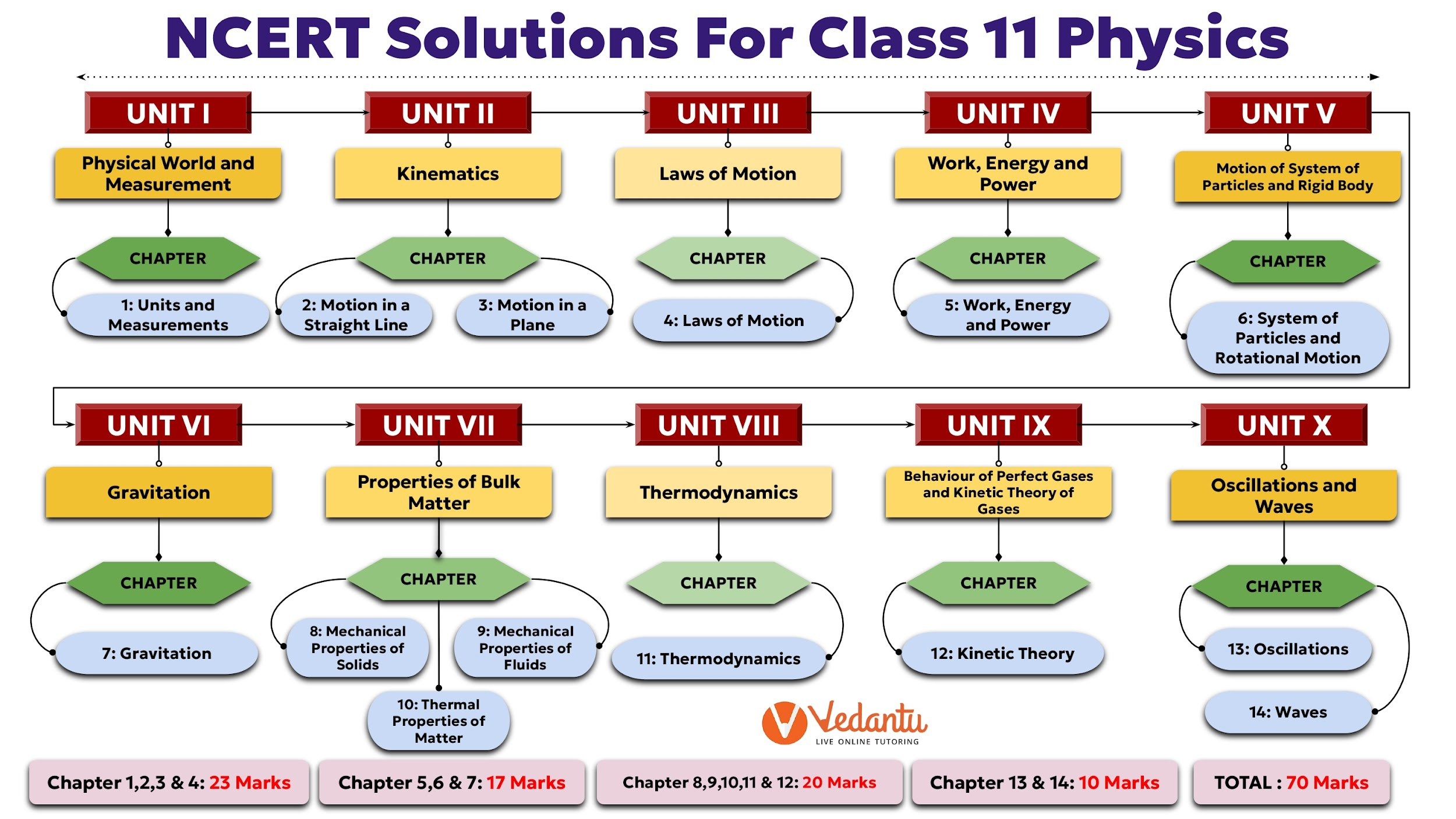NCERT Solutions Class 11 Physics- Chapter-wise FREE PDF Downloa
FAQs on NCERT Solutions for Class 11 Physics - Free Latest PDF (2024-25)
1. Why should I opt for NCERT Solutions for Class 11 Physics?
NCERT Solutions for Class 11 Physics can be extremely beneficial for finding solutions to textbook problems at one place. Many students find Class 11 Physics chapters difficult initially as the syllabus is a bit vast for students and the concepts are new. Hence, a student must opt for NCERT Solutions provided by e-learning sites like Vedantu to clear all their doubts regarding any question. This will help them to prepare for the exams in a better way. Class 11 Physics syllabus is crucial in cracking competitive exams like NEET and JEE. Hence, students must concentrate on the subject. NCERT Solutions will be a great help in expanding the subject knowledge of students and helping them to solve every problem correctly.
2. How Many NCERT Textbooks are there for Class 11 Physics and How Many Chapters each Contain?
NCERT Physics syllabus is divided into two parts: Part 1 and Part 2. There are a total of 15 chapters; Part 1 consists of 8 chapters and the remaining 7 chapters are there in part 2. The chapters in Physics Part 1 are (Chapter 1) Units and Measurement, (Chapter 2) Motion in a Straight Line, (Chapter 3) Motion in a Plane, (Chapter 4) Laws of Motion, (Chapter 5) Work- Energy and Power, (Chapter 6) Systems of Particles and Rotational Motion, (Chapter 7) Gravitation. The chapters in Part 2 are (Chapter 8) Mechanical Properties of Solids, (Chapter 9) Mechanical Properties of Fluids, (Chapter 10) Thermal Properties of Matter, (Chapter 11) Thermodynamics, (Chapter 12) Kinetic Theory, (Chapter 13) Oscillations, (Chapter 14) Waves.
3. Which is the Easiest Chapter of Class 11 Physics NCERT Textbook?
If a student focuses on the topics properly and makes a habit of practising enough questions related to them, no chapter is difficult in Class 11 Physics textbook. Students usually get frightened looking at the syllabus as the course content looks vast in the beginning. However, as the syllabus progresses, students are sure to get comfortable with the subject. If you are having any doubts regarding the subject or any question, you can seek help from the expert tutors at Vedantu who have years of experience in the field of teaching, You can also download NCERT Solutions for Class 11 Physics at absolutely no cost from Vedantu’s site.
4. Which chapter should I study first if I find Physics Class 11 difficult?
There are 15 chapters in NCERT Solutions for Class 11 Physics. These are of varying difficulties depending on the student. One of the simplest topics that are a part of these Chapters is Chapter 1 Physical world. Another easy yet important chapter is Chapter 2 Units and Measurement. All the chapters are explained in a simple and understandable manner in Vedantu’s solutions and students would benefit a lot by going through these solutions. So, starting with these topics will help build your confidence in the subject and help you proceed to the next chapters easily.
5. Is Class 11 Physics difficult?
No subject is difficult with the right guidance and practice. Among the subjects for Class 11, Physics is slightly more tricky than the others. It requires an understanding of concepts and strong basics to master them. Vedantu’s solutions for Class 11 Physics makes it easy to understand such difficult topics and concepts. It is explained in a simple yet captivating manner so that students can easily grasp and remember these basics throughout their life.
6. Which chapter is important in Class 11 Physics?
When it comes to Physics, all chapters are equally important. While some may be easy and some difficult, cumulatively these chapters help you score well and build a base for the future. Students are required to strictly follow the prescribed syllabus by the NCERT as this is what will be asked in the examinations. Vedantu’s NCERT solutions for Class 11 Physics also follows this very closely so students can rest easy while reading this as well. So, it will help you grasp the concepts better.
7. What is the syllabus of Class 11 Physics 2024-25?
The syllabus of Class 11 Physics 2024-25 is given on the NCERT official website. It is also the same syllabus followed by the officially prescribed NCERT Class 11 Physics textbook. The chapters that are a part of the syllabus are Physical world, Units and Measurements, Motion in a straight line, Motion in a plane, the law of Motion, Work, Energy, Power, Systems of Particles and Rotational Motion, Gravitation, Mechanical properties of Solids, Mechanical properties of Fluids, Thermal properties of Matter, Thermodynamics, Kinetic Theory, Oscillations, and Waves.
8. How to download the solutions for class 11 Physics Chapters?
Students can download Vedantu’s Class 11 solutions for Physics chapters by following these steps:
Visit the official Vedantu page
Choose the option of study material you will find
Choose the solutions of the chapter you need and you can go through it free of cost
Solutions for all chapters are available for the students to download at free of cost and make use of. These solutions are very trustworthy and reliable as they are formulated by experts and are also available on the Vedantu app.
























